
Clean Slate No 130 Winter/Spring 2024 £2.50
Scaling up community climate action

“Anyone can say they care about the environment but actually doing something about it, that’s different.
25 years ago, we built our first windmill and kicked off the green energy movement, and we’ve built quite a few more since then. We use all of our profits to build more.
You can join our mission to end the use of fossil fuels. Don’t just pay an energy bill, pay it to a company that will do some good with it – and invest in all of our futures.”
Dale Vince Ecotricity Founder


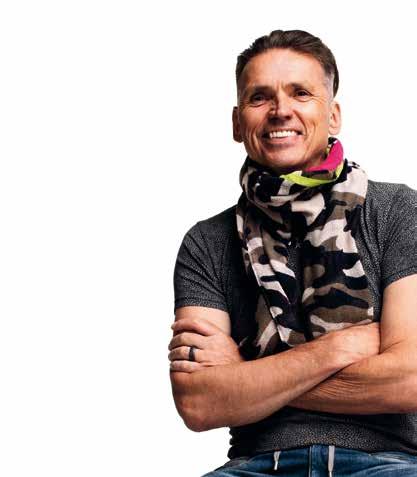
*£25 per fuel. Offer applies to new and existing customers switching to our Green Tariffs. Get £50 free credit!* Call free on 0808 123 0123 (quote CREDIT) or visit ecotricity.co.uk/cscredit
CONTENTS
IN THIS ISSUE
2. CAT news
The latest news from the Centre.
6. Scaling up climate action in your community
Whether you’re just setting up a new group or looking for inspiration for your next project, take a look at some of our tips for taking action at a community level.
9. Taking back power
Paul Allen introduces a scheme local to CAT, Bro Dyfi Community Renewables, which shows what’s possible when communities come together to create change.
12. Why we teach… community solar
Next in our series looking at themes and topics explored by students on CAT Masters degrees, renewable energy lecturer Alan Owen looks at community solar.
14. Changing how we think about food
Co-founded by CAT graduate Chris Woodfield, Aber Food Surplus is a social enterprise helping their local community to revalue and reconnect with food. Catriona Toms reports.
16. Designs for life
CAT’s Sustainable Architecture students take a genuinely collaborative approach to improving life in an urban environment. Gwyn Stacey and Carl Meddings explain the impact this unique course has on both students and the communities they engage with.
19. A legacy that matters
Freya Randall shares the story of CAT supporter Elaine Overnell’s incredible gift to the future


With the absence of real climate leadership at COP28, recent announcements of new oil and gas licences in the UK, and delays to key net zero policies, high level action on the climate and biodiversity crisis is sadly lacking.
But across the CAT community, progress is being made every day. Equipped with the skills, knowledge and experience they need, people from all walks of life are making a difference. Local action across the country is creating a wave of change that is providing hope for the future. And CAT is engaging with communities big and small to inspire and empower them to act.
Through our Zero Carbon Britain Hub and Innovation Lab, we are helping community groups to identify the barriers holding them back and to work together to create change (pages 6-7). By working with local energy initiatives like Bro Dyfi Community Renewables, we are helping communities take power from polluting multinationals and put it back in the hands of residents (pages 9-10). And through training people in community solar, we are helping to build a more sustainable future street-by-street.
While government action towards a Zero Carbon Britain is essential, there is no time to sit back and wait for them to act. Together, we can make the practical changes needed in our communities and show others that a better future is possible.
Whether you’re already an active member of a community group taking action or you’re wondering where to start, I hope this edition of Clean Slate gives you the inspiration and information you need.
Keep in touch
Visit: cat.org.uk
Email: members@cat.org.uk
Call: 01654 705988
Write to: CAT, Machynlleth, SY20 9AZ
To avoid climate breakdown and catastrophic biodiversity loss, every one of us has a role to play. Thank you for playing yours.
Eileen Kinsman, co-Chief Executive Officer
Clean Slate 1
Cover image: Shutterstock/Rawpixel.com Editor: Catriona Toms. (catriona.toms@cat.org.uk) Design: Graham Preston. (grahamjpreston@hotmail.com). The opinions expressed are those of individual originators, not necessarily those of CAT. If you wish to use material from Clean Slate for furthering the aims of the environmental movement, please contact the editor. The printing of an advert in Clean Slate does not mean that the product or service has been endorsed by the magazine or by CAT. Published by CAT Charity Ltd., Machynlleth, Powys SY20 9AZ. Registered charity no. 265239 Printed by Welshpool Printing Group, Welshpool • 01938 552260 • www.wpg-group.com
The power of community EDITORIAL Eileen Kinsman
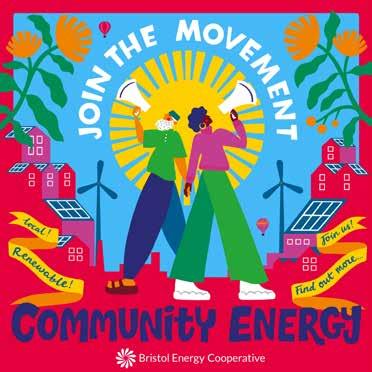

zoe-power Find out more and book your place online at cat.org.uk/short-courses or call us on 01654 705950 More courses are being added all the time – please see our website for up-to date listings.



Join the community energy movement Bristol Energy Cooperative delivers groundbreaking community-owned renewable energy
Get your free digital poster
by artist Zoe
to print out and spread the word.
cat.org.uk/short-courses • 01654 705950 • courses@cat.org.uk APRIL 2024 11 Zero Carbon Britain: Carbon Literacy for Communities 12 – 15 Build a Tiny House 13 Renewables for Households: Heat Pumps 27 – 28 Build a Small Wind Turbine 27 Compost Toilets 27 – 28 Reedbeds and Waste Water Management MAY 2024 18 Renewables for Households: Solar Hot Water 25 All about Bees: A Family Day Out JUNE 2024 3 – 6 Eco Refurbishment 8 – 9 Fixing Your Damp House 8 – 9 Self-build Project Management 19 Zero Carbon Britain: Live Online – Scaling-up Community Action 24 – 28 International Zero Carbon Energy 24 – 28 The Science of Sustainable Food Production 25 Zero Carbon Britain: Carbon Literacy for Local Authorities Online 29 Renewables for Households: Solar PV
26 – 29 July A Way of Building: Using Locally Sourced Materials 12 – 15 August Timber Framing for Everyone 10 – 11 August Cob Building 30 Sept – 3 Oct Eco Refurbishment
installations.
designed
Power
www.bristolenergy.coop/bec-
SHORT COURSES
Looking ahead
Spring/Summer 2024
Retrofit Reimagined

At the end of last year, we were delighted to host the Wales leg of the Retrofit Reimagined Festival, coordinated by our friends at Civic Square.
Over a weekend of inspirational talks, workshops, displays, film screenings, discussions, and much more, we explored how we can work together in our communities to create change.
Inspirational speakers and practitioners from all areas of

CAT joins Protecting our Planet Day for schools
In November, CAT took part in Protecting our Planet 23, a day run by STEM Learning dedicated to inspiring school pupils about environmental issues and solutions.
Experts from around the world engaged more than 100,000 school pupils in live-streamed talks and activities. These were accompanied by recorded sessions and classroom resources, all full of information and inspiration on tackling climate change and biodiversity loss.
Sessions from CAT looked at the importance of forest ecosystems and how we can protect and restore forests and address climate change. Professor Richard Lucas led a live link-up from CAT’s Living Wales Exhibition, joined online by researchers from around the world. From Welsh woodlands and Italian mountain forests to Australian mangroves and Malaysian tropical forests, we explored the wonders of these amazing ecosystems, the impacts of human activities, the action being taken to secure a better future, and what more needs to be done.
Find out more about CAT’s work with schools, including school visits to our eco centre and online workshops, at cat.org.uk/schoolvisits

retrofit and community climate action shared their knowledge and experience with an audience of all backgrounds and ages. We were immersed in making, doing, learning and building together, discussing how we rebuild our relationships to land, materials and each other.
Talks and workshops included Doughnut Economics and the Built Environment, an Introduction to Home Insulation, Whole House Retrofit in Wales, Basic Tool Skills, and a Sustainable Building Tour.
As well as at CAT, Retrofit Reimagined events took place across the UK, with gatherings in Birmingham, Glasgow, Bristol and London.
CAT members’ conference – a festival of ideas
Our 50th anniversary CAT members’ conference in November was an excellent opportunity to bring together our diverse community and discuss our common goal, building and sharing solutions to the climate and nature crisis.
Together, we looked back at five decades of environmental innovation and education, and forward to the next chapter.
We journeyed back through time to CAT’s humble beginnings through our special 50th anniversary photography exhibition, had an opportunity to ask our Co-CEO Eileen Kinsman about our exciting development plans and where’s next for CAT, and experienced our Zero Carbon Britain Innovation Lab process, helping members explore the actions they can take in their local community.
A huge thank you to everyone who joined us and made it such a memorable event. Our next members’ conference will take place on 11-13 October 2024. We hope to see you there! Sign up to our enewsletter to receive an email when bookings open: cat.org.uk/sign-up

Clean Slate 5 CAT news
Co-founder and Director of Civic Square, Immy Kaur gives the welcome address at the inspiring weekend.
Conference participants sharing knowledge and experience in CAT's Sheppard Lecture Theatre.
Scaling up climate action in your community
In the face of climate change and increasing energy insecurity, action is needed at all levels. While continuing to demand leadership from national government, communities and their local authorities must collaborate on renewables, energy demand reduction, land-use change, and wider behaviour change. Does your community have a comprehensive plan to support a transition to a zero carbon Britain? Here are some tips to get you started…
Create inclusive community stakeholder processes
Climate change and ways of mitigating and adapting to it affect us all, and everyone has the right to a voice. Good community engagement can lead to better decision making, increased understanding of barriers, and more sustainable ways forward.
Detailed stakeholder mapping can help you think about who should be involved in your community group so that you can take proactive steps to ensure everyone is represented.
From the venues and speakers you choose, to the times and formats of meetings, to where and how you promote your group or initiative – think carefully about how these can help to make what you do more accessible, diverse and inclusive.
Engage other groups and networks
Building partnerships with others can accelerate progress towards your shared goals. Think strategically about skills and resources you may be lacking and areas where partnering with others could strengthen your group and increase its impact.
Teaming up with like-minded community groups could boost your resources, develop your social networks, and revitalise your efforts.
Working in coalition with local councils, businesses and charities could deliver

value to all involved and increase your reach and effectiveness. It may help you secure funding, open communication with new audiences, or provide a fresh perspective from those with their own unique experiences.
Work together to co-create a local vision
When developing a local action plan, a good place to start can be co-creating a vision for your community in five, 10 or 30 years and exploring ways of working towards it.
At CAT, we use several approaches to help groups think about the future they want (and don’t want) to see, to understand the barriers to achieving this vision, and to investigate ways to overcome them.
One example is scenario planning, where we explore long-term environmental, social, technical, cultural and political trends and imagine plausible and desirable alternative futures. This can spark the imagination and help us think about the future we want and how we can collectively work to achieve it.
We also use the Three Horizons method, which helps groups think about where they are now, where they want to get to, and the actions they can take to move towards the desired future. It’s a powerful tool for exploring action you can take as a community.
Harness community energy
Community-owned renewable energy projects have an important role to play in securing power for local people and feeding clean electricity into the grid, helping to decarbonise the UK.
There are a range of benefits for local people on top of the positive environmental impacts: lowering energy bills; creating jobs and attracting investment to boost the local economy; bringing in an income to make more local projects possible; getting people together to improve the area; and providing visible evidence that local action can make change happen.
Are there natural resources in or near your community that could be used to generate
Shutterstock/elenabsl 6 Clean Slate
electricity, such as a river or windy hilltop? Are there public buildings, like schools or sports clubs, that could be transformed into a mini power station with the addition of rooftop solar PV panels?
See pages 9-10 for an example of a successful community energy project that CAT has been working with for over 20 years, and pages 12-13 for advice on neighbourhood solar projects.
Promote community land projects for food and regeneration
Community groups across the country are successfully transforming how the land around them is used. By focusing on improving soil health, abundant community gardens are possible with minimal human intervention. This can have a significant impact on food security and biodiversity. And there are wider benefits to people’s health and wellbeing, through nurturing the natural world, spending more time outdoors, and developing new social relationships.
Look for multi-solving opportunities
Many actions to reduce emissions can deliver knock-on benefits in this way, improving health,

increasing energy security, addressing fuel poverty, improving local transport, creating local green jobs, and bringing communities together.
This type of ‘multi-solving’, where a range of community issues are addressed by meeting the challenge of the climate and biodiversity crises, is crucial. By raising awareness of the co-benefits of positive environmental action, more people and organisations can be engaged and collaborated with. By considering these, we can create powerful networks across a range of interest groups.
Lead by example
Action at the community level can have a much bigger impact than individuals acting alone. By taking advantage of economies of scale and sharing skills and experience, groups of local people can make significant changes happen in their neighbourhoods.
Even small projects can be hugely worthwhile through the way they inspire and encourage others to start and develop their own initiatives. When people see that change it possible, it gives them hope that a better future for themselves and their community is possible.
Get skilled up
Whatever stage you’re at in taking climate action in your community, CAT can help you keep developing your knowledge, skills and networks.
Our new Zero Carbon Britain short course is ideal for anyone who is active in their local community and wants to understand how the UK could rise to the climate challenge.
At our Zero Zero Carbon Britain: Live Online – Scaling-up Community Action
course this June, you’ll explore important topics related to the question of how communities can take the next-step on the road to a just transition and better engage with the wider transition process around them. We will draw on CAT’s own Zero Carbon Britain research, and hard-won experience of communities around the country.
You’ll explore:
• The big picture – bringing you up to speed on the latest ever-evolving climate and biodiversity science, and related efforts to respond at the international, national and local levels.
• Zero Carbon Britain research –addressing crucial questions such as: How can we provide a reliable 100% renewable energy supply for the UK? How can we grow the food we need for a healthy, low carbon diet? How can we ensure the future we leave for generations to come is safe and sustainable?
• Creating, implementing and developing a local vision – hearing from community groups who have taken the national Zero Carbon Britain research as a model and applied it to their location.
• Engaging with the wider transition process – discussing how communities can collaborate with others at the local, regional, devolved and national level to scale-up community empowerment in the transition to zero carbon communities.
• Next-steps – planning your community’s journey to a just, regenerative, zero carbon society.
See https://cat.org.uk/events/zerocarbon-britain-live-online-scaling-upcommunity-action/ for more details and to book your place. CS
Clean Slate 7
getting an up-close view of wind power in action, and the new solar array will add additional learning opportunities. BDCR members also regularly teach and present at CAT, about both the benefits of community energy and the technical aspects of wind and solar. This provides us with an invaluable local showcase of a community taking power into its own hands.
Inspired to get involved with community energy?
Find out more at the BDCR website at bdcr.org.uk and visit CAT’s Zero Carbon Britain online resource hub for further information and advice. You’ll find links to community energy support organisations as well as guides, case studies and courses from a range of experts, helping you take action today. cat.org.uk/zcb-online-resource-hub CS
About the author
Paul is CAT’s Zero Carbon Britain Knowledge and Outreach Coordinator. He has been involved with our research into zero carbon scenarios since the beginning, coordinating the development of research reports and liaising directly with government, industry, NGOs and the arts to share findings.
Learning from experience
BDCR Chair Rod Edwards and Committee Member Tim Brewer share some key learnings from 25 years spent supporting community energy in the Dyfi Valley.
What are you most proud of in terms of the impact BDCR has had within the community?
Tim: Most of our shareholders live within the Dyfi Valley and therefore the annual share interest payments we have made to them over the last 25 years have remained within the local community. More recently, with the increase in electricity prices, we have been able to spend a proportion of this extra revenue (around £60k) in the community, helping to fund various local projects.
Rod: Particularly in the early days, the project raised awareness in the area of the issue of where energy comes from, and how renewable energy can contribute to the abatement of carbon emissions.
What were the main challenges, and how were these overcome?

Tim: There have been many challenges over the last 25 years – both technical and organisational. From an organisational point of view, maintaining the cohesion and enthusiasm of the management committee (all of whom volunteer their time) has proved difficult at times.
Technically there have been challenges with some of our projects. For example, due to ground conditions, the solar project required a different approach to traditional construction methods for groundmounted PV, without the use of 'mass concrete'.
Rod: Having experienced engineers within the core team has certainly helped with these types of challenges! The legal, financial and planning challenges should not be underestimated either. There are a number of different legal structures for cooperative enterprises, arranging a share offer can have challenges, and planning can be a protracted process. Using the help of specialised professional experts in these areas may well be worth the cost.

It’s also important to consider the time and energy needed for the ongoing running of the project. Where possible, we would advise that some of the generation income should be used to employ someone locally to support this side of things.
Do you have any key pieces of advice for anyone thinking of setting up a new community renewables scheme?
Tim: Canvass your local community thoroughly, mainly to ascertain what their appetite is and what they would like to achieve. There’s no point putting up a wind turbine if there is no support for one in the community.
Make best use of members’ skills. Chartered civil, electrical or mechanical engineers are good people to have on board, but people who just have enthusiasm are equally useful.


Keep your project costs as low as possible so that you can start to see the community benefits relatively quickly – there’s no point borrowing millions of pounds and taking 30 years to pay it back!
Rod and Tim are both renewable energy engineers. As well as working with BDCR and other local organisations, they are both regular guest tutors at CAT, giving presentations, workshops and tours to students and visiting groups.
10 Clean Slate
'Nora' being installed in the hills above CAT.
Inset: Community opening of the first wind turbine.





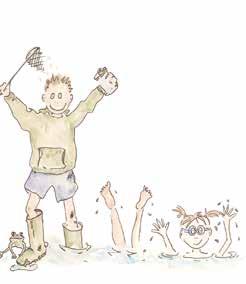
Your support gives people across the UK and beyond the knowledge and skills to build a better world. It’s a gift for everyone who will benefit from a safe, healthy and fair future in which nature thrives – including our children and future generations. CAT members everywhere are putting urgent solutions into action. Buy someone the gift of membership today by calling 01654 705988 or visiting cat.org.uk/giftmembership For more information please contact us at members@cat.org.uk BUY SOMEONE THE GIFT OF SUSTAINABILITY CAT membership is a gift for everyone, everywhere. Litho & Digital Print Large Format Print Banners & Signs Vehicle Graphics Personalised Clothing Promotional Products Direct Mail Fulfilment Trophies & Awards CALL US ON 01938 552260 EMAIL US AT sales@wpg-group.com VISIT OUR WEBSITE Sustainable Print Solutions We have a range of Eco-Friendly products RECYCLED FSC CERTIFIED CARBON BALANCED SUSTAINABLE BIODEGRADABLE ORGANIC . . . NEW NEWNEW Imaginative Holidays for Imaginative Children at CAT, in the Peak District and on the Isle of Man
days
cakes
Centre Saturday 20th - Saturday 27th July CAT EcoCabins Saturday 27th July - Saturday 3rd August Saturday 3rd - Saturday 10th August Isle of Man Sunday 11th - Sunday 18th August All weeks £400 Includes IoM ferries Escorted coach travel from Birmingham to CAT and to IoM ferries available at cost. EcoWeek
www.ecoweek.org.uk
Seven
for 8-15 year olds to save the planet, play games, sing songs, make friends and cook amazing chocolate
Foundry
Camps 2024
WHY WE TEACH — Community solar
Next in our series looking at themes and topics explored by students on CAT Masters degrees, Alan Owen introduces community solar, which we teach to students on a number of our postgraduate courses, including our Sustainability in Energy Provision and Demand Management MSc.
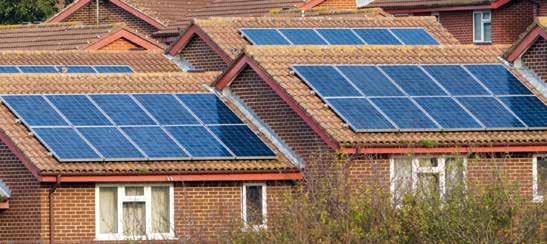
We often associate community energy projects with microhydro schemes or wind turbines, with share offers and investment opportunities for local people. However, at an even more local level, and particularly in towns and cities, we can work on a street-by-street basis to implement community solar schemes that can bring significant environmental and cost benefits.
As well as teaching students about this topic, we also provide training to community groups to help people implement renewable energy schemes of their own.
Why is the topic important?
Avoiding catastrophic climate breakdown demands we move away from fossil fuels and towards more sustainable means of energy production. This means both significantly powering down energy demand, through improvements in energy efficiency, changes to transport and transforming industry, and powering up supplies of renewable energy.
By now, we’re all familiar with the environmental and cost-saving benefits of solar photovoltaic (PV) panels. These benefits can be further amplified if people work together to install PV panels across an entire street or housing estate. Whole neighbourhoods can be turned into power
stations, supplying renewable electricity all year round.
This community approach allows for a more efficient use of energy, budget and resources than installing panels individually.
• The energy-returned-on-energyinvested (EROEI) can be much better for a project covering 20 homes than for 20 individual installations. Factors in this include reduction in resource demand (particularly conflict materials), transport of materials and installers to the site (one trip vs 20 trips) and better use of available space.
• It makes community PV better value for money than a system installed on a single home, because buying the equipment in bulk brings the price down, and installing a larger system takes less time than installing multiple small systems.
• The output is more easily used by everyone, so more of the energy generated is available for displacement, i.e. using energy from a community system at the point of generation displaces grid consumption, which means it has the same value per kWh as buying from the grid, whereas selling back to the grid gives only a small fraction of the income.
• It can introduce greater local energy
resilience, as a community supply can easily be set up so that it can connect to and disconnect from the grid as needed.
• Because community PV is more cost effective, supporting street-by-street or whole neighbourhood installations is also potentially a more effective use of government grant funding than providing subsidies or grants for individual households to install PV.
There are also the wider benefits of people getting to know their neighbours better and working together as a community. Solar projects can be a great way to kick-start other community action or build on existing schemes.
What are the main aspects to consider?
First, we teach that reducing energy demand is a crucial step. We explore types of home insulation and ways of reducing energy demand through behaviour change as well as technology use.
Next, we think about the different space available in a neighbourhood. Generally, people’s first thought is to install PV on roofs, but cleaning and maintenance is easier with ground-mounted systems, so suitable areas of land should also be considered.
Wherever PV panels are sited, general rules apply – for example, they need to be south facing and not shaded by trees
12 Clean Slate
Shutterstock/Marcin Rogozinski
A community approach allows for a more efficient use of energy, budget and resources than installing panels individually.
or buildings to ensure maximum power generation. Students look at these rules in detail.
Finally, we discuss the option for neighbourhood groups to work together to buy shares in a company or community group that is installing renewable energy systems elsewhere – the impact may not feel as direct, but it may be a more efficient use of resources, particularly if their own site isn’t well suited to PV.
What are the teaching methods?
Students learn about community solar through a range of teaching methods:
• Data calculations using Excel spreadsheets and a bit of maths.
• Looking at how PV works, using physics.
• Practical sessions calculating maximum power points, horizon mapping and sun path diagrams to work out what electricity you might expect to generate from PV panels on a particular site.
• Looking at how to create consumption profiles for households – what devices people use, when, how often, and what their power rating is.
• Calculating energy-return-on-energyinvested, looking at the energy it takes to make and install the PV panels vs the expected energy outputs.
• Life cycle analyses, exploring the environmental and human impacts from producing PV panels to end-of-life disposal.
• Using the PV panels on the CAT site to learn how to test output and compare different systems.
External guest lecturers – for example, Nikki Pillinger, ‘The Grid Queen’, a senior engineer who works with big solar installations – add a unique perspective.
But it’s not all about the technical details – we get students thinking about the bigger picture too, looking at how technologies will impact what we do in the future, the benefits and challenges for future societies in terms of resource use, waste disposal, and energy justice. Students consider the future they want to see and the potential impacts of the choices we make today.
How do students use this learning? Students from a wide range of backgrounds come to study our courses – many of whom are looking to change careers to work in an area they really care about and that will allow them to make a positive impact in the world.
Many CAT graduates have gone on to work in community energy schemes or with local authorities across the UK.
We also have graduates working to advance renewable energy in other countries around the world. For example, a graduate who used to work in the medical industry and had no engineering background is now working in energy management in South East Asia. CS
Study with us
Find out more about CAT Masters degrees, join an on-site or virtual open day, and explore what funding might be available to you – visit our Graduate School web pages or contact Alis at study@cat.org.uk or on +44 (0)1654 705953.
Alan also teaches our ‘Renewable Energy for Households’ series of one-day courses, covering everything from heat pumps to solar. Find out more at cat.org. uk/short-courses
About the author
Alan is a Senior Lecturer in CAT's Sustainability in Energy Provision and Demand Management MSc, and teaches renewable energy systems on a number of our other Masters degrees and short courses. He is a Chartered Energy Engineer, with 30 years’ experience in renewable energy and has taught at a number of universities, including Heriot Watt and Robert Gordon.
MSc Sustainability and Adaptation
MSc Sustainability in Energy Provision and Demand Management
MSc Green Building
MSc Sustainability and Behaviour Change
MSc Sustainable Food and Natural Resources
MSc Sustainability and Ecology
MArch Sustainable Architecture
MRes Sustainability and Adaptation
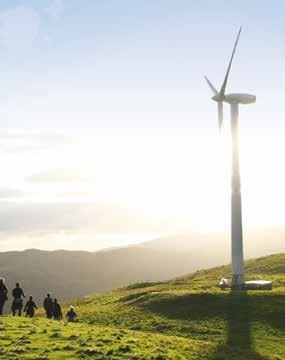
Gain the skills, knowledge and networks to help create a zero carbon world.
Practical academic courses from leading experts in behaviour change, food, ecology, energy, buildings, and architecture.
Clean Slate 13
www.cat.org.uk | study@cat.org.uk | +44 (0) 1654 705953 GRADUATE SCHOOL OF THE ENVIRONMENT
DISTANCE LEARNING AND PART-TIME OPTIONS AVAILABLE
CLIMATE SOLUTIONS MASTERS DEGREES
Changing how we think about food
Co-founded by CAT graduate Chris Woodfield, Aber Food Surplus is a social enterprise on a mission to help their local community to revalue and reconnect with food. Catriona Toms reports.

Based in the Mid Wales coastal town of Aberystwyth (known locally as ‘Aber’), Aber Food Surplus is a pioneering not-for-profit focused on supporting a thriving and circular local food system.
Initially set up in 2017 to tackle food industry waste by collecting and redistributing food that local supermarkets were throwing away, the organisation has grown and expanded in recent years to take a broader systemic approach to transforming local food systems.
Redistributing ‘waste’ food
By collecting the food local businesses are throwing away and redistributing it among the community, the project is exposing problems with the food industry.
Volunteers currently collect around 250kg of food from Aberystwyth’s supermarkets each week. Through Food Sharing and Pay As You Feel meals, they bring local people together and show them ‘waste’ food can be tasty and nutritious.
The project is run by the community for the community, operating in a collaborative, creative and constructive way. The goal is to turn Aberystwyth into a zero-food-waste town.
Exploring wider system change
However, the team recognise that collecting and redistributing surplus food doesn’t tackle the root cause of the problem of waste within the food industry, or wider systemic issues within the food system.
An important part of the project is starting conversations. How can we move to a system that doesn’t produce systemic food waste, pollution and loss of biodiversity? What would that look like in Aberystwyth? What benefits could it bring for people’s health, wellbeing and security? How else can we support a circular and thriving food system? What would our community and food system look like if we had more growing spaces, and more people were growing food in sustainable and regenerative ways?
Through these discussions about the food system, and utilising food waste as a way to bring people together, the project aims to inspire people to talk about local issues and how to support Aberystwyth’s people, economy and environment. It encourages and empowers everyone to contribute to making change happen, whether at home, school or work.
“Our vision is for Aberystwyth to be a pioneering example of food sustainability. A place where food is grown, distributed and consumed in a fair and environmentally sustainable way. Where people of all ages and backgrounds come together to enjoy tasty and nutritious food. Where food waste is a thing of the past.”
Co-founder, Chris Woodfield

Food sharing hub
With funding from the National Lottery Community Fund, Aber Food Surplus also now runs a community and environmental hub in Aberystwyth. The aim of the space is to be a welcoming, relaxing and inclusive place for anyone to think about and discuss the food system, our connection with food, and wider climate and environmental issues, and to get involved with taking positive action at home and in the community.
From here, a team of volunteers runs a surplus veg box scheme, operates a community fridge, and facilitates community activities. It is also the home of the Bwyd Dyfi Hub, which distributes organic, local, and agroecologically grown produce, helping people eat in-season and support local producers.
The food sharing hub also hosts a seed library, where people can collect and drop
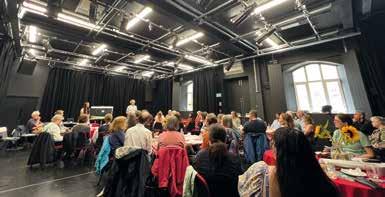
14 Clean Slate
Redistributing food that would otherwise go to waste offers a starting point for conversations about the wider food system.
'Pay As You Feel' meals bring people together and get them thinking about the value of food.
Chris speaking at a Food Assembly event in Aberystwyth in July 2023, exploring the future of food in collaboration with the Office of the Future Generations Commissioner.
DESIGNS FOR LIFE
Through CAT’s MArch Sustainable Architecture course, students take a genuinely collaborative approach to improving life in an urban environment. Gwyn Stacey, Senior Lecturer, and Carl Meddings, Programme Leader, explain the impact this unique course has on both students and the communities they engage with.

Our built environment and the way we arrange communities around it is one of the most important factors in determining our quality of life. Human wellbeing is often linked to being part of thriving and active communities that can adapt and shape the places they occupy.
One of the first projects students on CAT’s MArch Sustainable Architecture course are given is an exploration of urban living and the relationships between the built environment and its inhabitation. This is viewed through the interrelated lenses of sustainability, resilience, adaptation, and prosperity.
The project requires students to collaborate in researching place and people in an urban settlement and the relationship with surrounding areas. The research examines a wide range of economic and environmental factors. Students are asked to consider the specific context of a place, its communities, and the challenges they face in relation to both climate change and other socioenvironmental issues.
Engaging communities
Fundamental to this research is engagement with the community, to ‘get under the skin’ of the issues facing them,
and to listen and respond with an open mind. Rather than developing master plans and imposing urban design ideas, we ask students to really get to know the local people and respond with empathy and respect to what they find.
In this way, we seek to question not just what should (or perhaps should not) be designed but, more fundamentally, what an inclusive, responsive design process should be. This is a hands-on approach to engagement with people and places that leads to a thorough understanding of local needs and how informed interventions (sometimes very minor) can be truly transformative.
“In Llanelli, our project was about connecting with the community by utilising skills learnt at CAT to engage with local people. Whilst sharing a meal, we heard their stories, favourite memories and hopes for the future of the town. We asked people to write notes to Llanelli on postcards, helping us to build a picture of the town's diverse character. The opportunity helped me contextualise my work, grounding my design project in the real experiences of the town. The genuine warmth we received in Llanelli was a truly impactful experience in our creative journey.”
Anna Drost, student
Unique problems…
Wales has urban and rural settlements with a broad spectrum of conditions, needs, problems and concerns, making it an ideal place to examine the way we live. In recent years, students on the course have engaged with communities in Caernarfon, Milford Haven and Conwy/Llandudno Junction. Last year, the focus was on Llanelli, a town facing a particular set of challenges and also new potentially beneficial opportunities. We were able to link up with a highly socially engaged organisation called People Speak Up, who were ideal hosts to help develop a plan for community engagement.
Our students first walked around the town, to get a broad understanding of its context, shape, activities, patterns of life, and interactions. They then worked collaboratively on a plan for community engagement, which included a feast and on-street discussions and consultations. For the feast, the students invited and cooked for more than 80 community members. The event was not just about
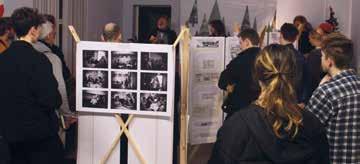
16 Clean Slate
Students organised a range of engagement events, including a community feast, to find out more about what local people wanted for their town.
A pop-up exhibition in Llanelli allowed students to share their work with the local community, continuing the conversation.
gathering information, but also an opportunity to bring people together to discuss life in the town.
“Llanelli is a post-industrial town with an infrastructure, like so many other places in Wales, which seems to be at odds with the needs of the people who live there. Through working with the community, we explored poverty, housing need, local business support, and infrastructural and cultural ideas. Together, we discussed ways to re-imagine the familiar with the residents and proposed ideas for change. The ideas presented are hopeful proposals for a town which needs to come together to make safe, sustainable and social places.” Owen Griffiths, tutor
…and solutions
From the research, prepared and presented in groups, a design brief was developed. The students created a ‘placeplan’, appropriate to the local context and community. A place-plan need not just be physical intervention, but a mechanism, framework or toolkit to embed meaning and activity in its physical setting. This could be a series of events or connecting organisations across several spaces.
Working in pairs, the students developed their place-plans further to include design interventions, landscape and building proposals, building reuse and revival, activities, events, and the development of amenities – small projects with the potential to make a substantially larger impact.
While a traditional imposed masterplan
Example student project
Students: Alexia and Alfie
typically involves little feedback or follow up with the community, leading to fatigue and cynicism, the place-plan approach is radically different. It allows the participants and others to continue the conversation, which might ultimately lead to real action and communal activity.
To this end, we returned to Llanelli a few months after our first engagement to put on a pop-up exhibition in a community venue and then display the students’ responses in an empty shop unit in the town centre. The students gave feedback on the consultation, heard more ideas from the exhibition visitors, and contributed to the ongoing discussion about Llanelli by its inhabitants.
Following this, the students’ work will be compiled digitally and passed back to those that engaged with us to serve as a set of ideas that can spark conversations for the future. CS
About the authors
Gwyn Stacey is a Senior Lecturer on the MArch Sustainable Architecture course. He is a former student of CAT’s Professional Diploma in Architecture and now, alongside his role at CAT, is developing his practice work with a community focus in rural Wales, and working with and supporting conservation organisations.
Carl is the Programme Leader for the MArch course. He is an architect and educator with a passion for educating architects in a rapidly changing cultural and professional environment. Before
Project: Hadu (to bring forth or grow seed, multiply, become fruitful)
Llanelli has been struggling in recent years. The town has been affected by economic hardships, competition from out-of-town traders, and described by locals as “rotting from the centre”. This scheme aims to work with existing networks of community groups to draw life back into the centre of town.
Llanelli’s covered market was once the heart of the town. But in recent years it has seen dwindling numbers of visitors and many of the stalls are becoming empty. Historically, the stalls and cafes in Llanelli’s covered market provided social spaces where regular customers came to see familiar faces and chat.
By building upon the multi-storey car park above the covered market, our proposal aims to reinvigorate this existing hub of the local community.
The under-used top two floors of the carpark would be reappropriated as spaces for learning, up-skilling, and food production. The fourth floor would provide youth-based workshop spaces, as well as sound studios. This would help address a desperate need for a free place where young people can meet, while also encouraging skills training. The top
About the course
The MArch Sustainable Architecture course is accredited by the Architects Registration Board as a part 2 of the professional route to qualification as an architect. The course builds upon CAT’s 50 years of experience in sustainability practice, enabling students to investigate a different approach to architecture that confronts issues of climate change mitigation and adaptation at every level of architectural thinking.
The way the course is designed requires students to attend CAT for one week each month. In between the on-site weeks, students work from home and collaborate with tutors and each other online. The ‘teaching’ weeks on site are immersive, intense and stimulating. Students work collaboratively on design projects, engage in workshops covering a wide range of activities, and attend lectures, seminars and presentations from expert contributors.
teaching at CAT, he was the Subject Leader for architecture at the University of Huddersfield and has taught at all levels from first-year undergraduate to final year at masters and beyond.

floor would be used as an allotment and teaching space, where training and volunteering would help promote a local network of healthy food production. Local commercial and market food waste would be recycled through anaerobic digestion to make digestate for fertiliser and biogas for cooking.
This new mix of activities, built upon the covered market, would hopefully bring renewed interest to the centre of Llanelli and provide a noncommercial space to socialise, learn and grow.
Clean Slate 17
Alegacy that matters
Gifts in wills, from compassionate people like you, make so much of what we do possible. These heartfelt donations are a belief in a safer, healthier and fairer future. They help equip a new generation of the CAT community with the knowledge, skills and experience to act in the climate and nature crisis. And they leave a personal legacy that will go on making an impact long into the future.
Every gift in a will is special. They are particularly meaningful when we can learn about the life of someone who cared enough to include CAT in their will.
When Elaine Overnell passed away in August 2020, her will stated her wish for a generous portion of her estate to be donated to charities including CAT. We helped Mike and Catherine Burt, executors of Elaine’s estate, to decide how best to use her kind gift and honour her memory.

Thinking of leaving a gift in your will?
If you would like to find out more about supporting CAT with a gift for the future, Freya is here to help at legacies@cat.org.uk or on 01654 523015. Freya is also on hand to support you as the executor of a loved one’s will.
We are incredibly grateful for every gift made in a will and take all opportunities to celebrate the lives of the caring people who shared our vision of a better world. Whatever the size of their gift, these special supporters live on through the positive impact they make. They are never forgotten. CS

In Mike’s words:
“Elaine was an early supporter and admirer of the work being undertaken at CAT. She will be remembered as adventuresome, in possession of a great admiration for natural philosophy, and with an enquiring mind that wanted to know the how and why of every practical matter.
Sustainability and organic gardening were important interests promoting a way of life in harmony with oneself and in unity with others and the environment.
Reflecting on Elaine’s advocacy for both education and sustainable development, we have chosen to support Sustainable Skills workshops as part of CAT’s future development plans.
We have also greatly appreciated the support that CAT have given to us in arranging a lasting memorial for Elaine adjacent to the WISE building. We hope that the words on the slate memorial used (with permission) from a poem by Henry Normal will continue to inspire students and visitors to CAT: Know that you matter to me. Life matters. There is little more to say.”
We offer our deepest thanks to Mike and Catherine for their commitment to Elaine’s legacy.

Clean Slate 19
Elaine loved to travel and experience other cultures – she is pictured here in Turkey in 1992 on one of her many walking holidays.
A lasting memorial in the CAT gardens celebrates Elaine's life. Mike, Catherine and friends gather at CAT to remember Elaine.
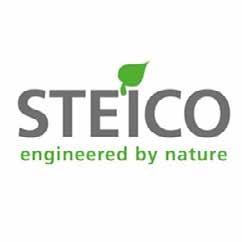

♦ SUSTAINABLE ♦ NATURAL ♦
CARBON MIKE WYE
from Tel: 01409 281644 | www.mikewye.co.uk | sales@mikewye.co.uk
High performance & environmentally friendly building products from renewable sources ECOLOGICAL
LOW
Available
Insulate properly for a healthy home wood fibre insulation






































